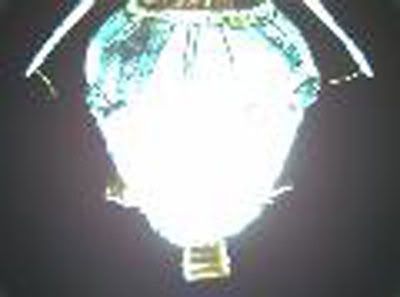By now, space geeks worldwide are aware that Bigelow Aerospace successfully launched and inflated the Genesis-1 spacecraft. There has been quite a bit of buzz about it in the space blogs over the last few days; Space Pragmatism (as always) has a good roundup of stories about it. You can track the Genesis-1 spacecraft here.

The Genesis series is a 1/3 scale model of the eventual Nautilus space station module, also under development by Bigelow. The Nautilus, with a volume of 330 cubic meters (11654 cubic feet), is by itself 3/4 of the volume of the International Space Station, so if the Genesis is 1/3 that volume then the Genesis is, all by itself, 1/4 of the volume of the ISS. However, the total cost of the Genesis, including development, production, and launch (aboard an old converted Russian ICBM) has been only 75 million dollars to date. That's about what NASA pisses away in 2 days.
Put another way, if the last shuttle launch cost 5 billion dollars (based on NASA's yearly shuttle budget and the number of launches in the last year), then for the same amount of money Bigelow could launch more than 60 Genesis modules. For the cost of one space shuttle flight, Bigelow could have the equivalent habitable volume in orbit to make 15 international space stations. Or, if we take the total cost so far of the ISS to be estimated at 100 billion dollars, then for the same amount of money Bigelow's inflatable modules could be used to build the same inhabitable volume as the ISS more than 300 times!
Of course, that is a bit of a simplification, but the two to three orders of magnitude difference in price has to be giving some people within the Bush administration and within NASA itself conniptions. And of course Bigelow wouldn't be launching more than 1300 Genesis modules either. Bigelow's plans call for larger and larger modules to be launched, ending up with space stations like the one in the diagram below (lifted from Bigelow's website):

This space station, with three Nautilus modules, would be a little over twice the interior volume of the ISS. Not shown in this diagram are things like solar panels and radiators, which would require additional launches and on-orbit assembly. But so what? The resulting structure will be double the size of the ISS for a fraction of the cost; if Bigelow's stated 500 million dollar commitment is a hard upper limit, then his station will end up costing one half of one percent of the cost of the ISS, but be twice the size.
So, what does this all mean to the koolaid-drinkin' alt-space community? For one thing, it means that Bigelow will be able to set up a destination for the orbital space tourist market to be served by Virgin Galactic, SpaceX, Rocketplane, and others. For another, it shows that private industry can do the same things that NASA has been doing for the last 30 years, at a miniscule fraction of the cost and with the possibility of doing so for a profit. Is it any wonder that the Office of Science and Technology is calling for the breakup of NASA?
Technorati Tags: Space, Bigelow, Genesis, NASA, International Space Station
No comments:
Post a Comment